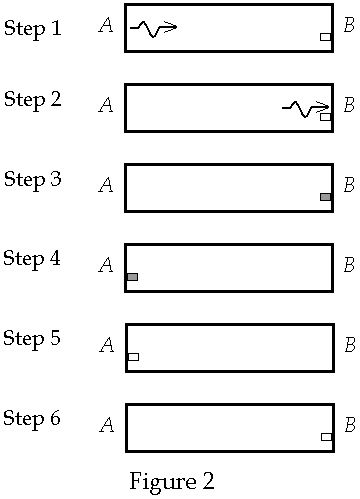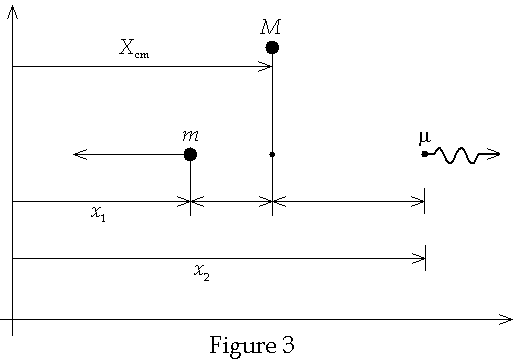
Einsteinís
Box
Back
to Physics World
Back to Special Relativity
In 1906
Einstein published a paper entitled The Principle of Conservation of the
Center of Gravity and the Inertia of Energy [Ref 1]. In this article
Einstein utilizes that center-of-mass theorem which states that the
center of mass of a closed system, which is initially at rest, will remain at
rest. Einsteinís paper consists of two sections. Section 1 is entitled A
special case. The second section is entitled On the Principle of the
Conservation of the Center of the motion of the center of gravity. It is the
second section that gives the more general version of the center of mass
theorem. Descried below is the first section. This section of Einsteinís paper
provides the springboard to the derivations given in the second section.
Consider a hollow
cylinder of mass M, which is initially at rest in an inertial frame of
reference S. The cylinder has two walls at each end of equal mass. Einstein
considers a six step process: The first step consists of a finite amount of
radiation (photons) of total energy E is emitter from end A
towards end B parallel to the axis of the cylinder as shown in Fig. 1
below

The spatial extent of the radiation is small compared to the length of the cylinder. In modern language we can think of this radiation as a single photon of the same energy. The relationship between the energy of an amount of radiation of energy E has an amount of radiation of magnitude p is
![]()
This is
the phenomenon of radiation pressure. In order for momentum to be
conserved momentum must be transferred to the cylinder, which then starts to
move with velocity v. Conservation of momentum then demands that
![]()
The
speed of the cylinder is then
![]()
The
speed of the box will remain constant until the radiation arrives at end B.
The wall then absorbs the radiation and the cylinder comes to rest. The flight
time, T, of the radiation is related to the speed of light and the
distance traveled. This distance is approximately L, the length of the
cylinder and thus
![]()
During
this time the cylinder moves a distance d
where
![]()
Next an
amount of energy E is transferred from wall B into a massless
carrier, k, collocated at wall B. The carrier then moves to wall A
wherein the energy E is transferred from the carrier to wall A.
The carrier then moves back to wall B. The whole system has undergone a complete
cycle which may be repeated an arbitrary number of times. These steps are shown
in Fig. 2 below

If the carrier remains massless even after it has absorbed an amount of energy E then the returning of the energy to wall A will not result in a change in position of the cylinder. This implies that the only result of this six-step cycle is to displace the body by an amount d. This shift can be made arbitrarily large by repeating the process. Thus if the assumption that the carrier remains massless is valid then the system, which was initially at rest, will have its center of mass shifted without any external forces acting on the system. This clearly violates the law of mechanics which states that a body, which is initially at rest, cannot undergo translational motion unless there is an external force acting on the body. Einstein therefore concludes
Ö,
if one assumes that any energy E possesses the inertia E/c2,
then the contradiction with the principle of mechanics disappears. For according
to the this assumption the carrier body of mass E/c2
while it transports the amount of energy E from B to A; and
since the center of gravity of the entire system must be at rest during
this process according to the center-of-mass theorem the cylinder K
undergoes during it a total shift Sí to the right..
where
the total shift Sí is given by d.
This result follows by examining the center of mass of this system, which
demands that an amount of mass, m, be transported to the right, i.e.
![]()
Substituting
the expression for d from Eq. (5) above we find

Canceling
like factors of M and L we arrive at the general result
![]()
In
section 2 Einstein uses this expression by assigning mass to the energy of
radiation. Einstein makes the substitution of the energy density of radiation
with a mass density when he stated that If we assign the electromagnetic
field too a mass density (re)..
Einsteinís
derivation has some conceptual problems with it, namely that Einstein treats the
cylinder as a rigid body, a concept that is inconsistent with the principles of
special relativity. Other variations have been offered since Einsteinís
article was published. French circumvents the rigid body problem and considers
only the two walls, A and B, of the box arriving at the same
result utilizing the center-of-mass theorem [2]. Antipa presented the idea of
considering instead an atom that emits a photon and applies the center-of-mass
theorem to the atom-photon system [3]. The following is a variation of that
approach, the only exception being a simplification which is effected by
employing the principle of the conservation of mass. Consider an atom of mass M
initially at rest in the inertial frame S at x = Xcm.
A photon of energy E and mass m is emitted in the +x-direction as
shown below in Fig. 3.

The mass of the atom is decreased to the new value m. The magnitude of the photonís momentum is given by Eq. (1) as p = E/c. Since the initial total momentum is zero the atom must have a momentum of the same magnitude and having the opposite direction. The atom must therefore be kicked in the x-direction and moves with speed v as illustrated in Fig. 3. The magnitude of the momentum of the atom is mv and has the same magnitude as the momentum of the photon, i.e. mv = p = E/c. Conservation of mass demands that
![]()
The
x-component of the center of mass vector is given by as
![]()
where the x-coordinate of the atom at time t is x1 and the x-coordinate of the photon at time t is x2. x-coordinate can be read off from Fig. 1. They have the values
![]()
Substituting Eq. (11) into Eq. (10) and multiplying through by M, gives
![]()
Substituting in Eq. (9) and expanding gives
![]()
Canceling like terms reduces Eq. (13) to
![]()
Solving for m and substituting mv = E/c gives
![]()
Note
that m
is the mass of the photon (not the proper mass). This is simply the
statement of mass-energy equivalence found in Eq. (8) above.
References:
[1] The Principle of
Conservation of the Center of Gravity and the Inertia of Energy, Albert
Einstein, Annalen der Physik, 20 (1906): 626-633.
[2] Special Relativity, A.P. French, The MIT Intro. Series,. W.W.
Norton & Co., (1968), page 16
[3] Inertia of Energy and the Liberated Photon, Adel Antipa, Am. J. Phys.
44(9), Sept 1976 (1976)
Back
to Special Relativity
Back to Physics World